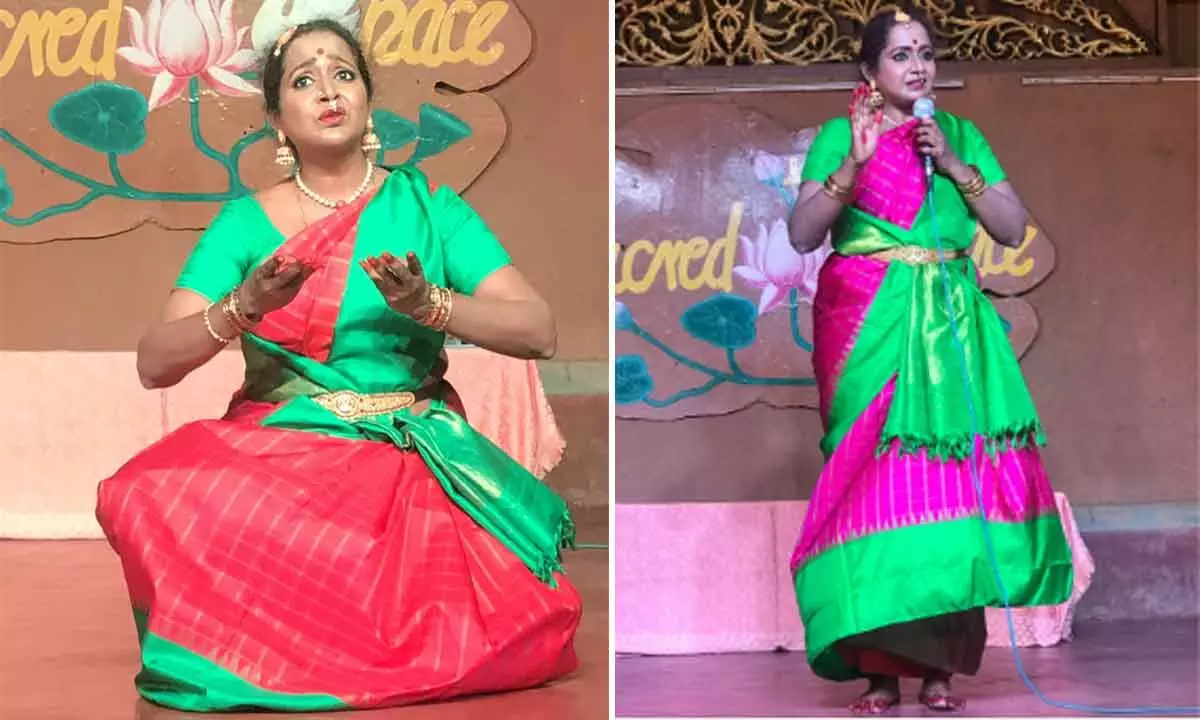Live
- They always want me to win, and now I feel lucky to have been offered a story like ‘Zebra’: Satyadev Kancharana
- ‘Democracy first, humanity first’: PM Modi in Guyana's parliament on two countries' similarities
- PKL Season 11: Telugu Titans register third straight win to top standings
- Is Pollution Contributing to Your COPD?
- NASA Unveils Underwater Robots for Exploring Jupiter's Moons
- Additional Central forces arrive in violence-hit Manipur
- AR Rahman and Saira Banu’s Divorce: Legal Insights into Common Issues in Bollywood Marriages
- 82.7 pc work completed in HPCL Rajasthan Refinery area: official
- Curfew relaxation extended in 5 Manipur districts on Friday
- Tab scam prompts Bengal govt to adopt caution over fund disbursement
Just In

Knowing the Devadasi through her repertoire” – Dr Yashoda Thakore explains and explores a forgotten Art
Our Sacred Space auditorium, under the guidance of Nayantara has undertaken the task of organising a series of lectures containing performances also to bring out the theoretical aspects of classical dances to better understand their historical and economic cum socio-cultural background. Emphasis was placed on these relatively lesser-known details to let rasikas share the latest knowledge, views and opinions of scholars and experts in these fields.
The artiste of the evening was Dr Yashoda Thakore, hailing from the traditional Kalavantulu family, cleared some misperceptions and explained that these dancers were simultaneously connected to the Temple and the Court. They took part in Baliharana and Dwajarohanam rituals along with the Priests and received land grants (manyams) instead of these services. The term Devadasi, with all its connotations, was used only in the colonial period. She was earlier unaware of her antecedents but is now trying to revive with both practice and research and stand out with pride as a representative of these ancient cultural traditions.
Body and posture expressed power and the lack of it in layers of nuanced meaning as she progressed through the repertoire. The opening prayer song depicted the stirring arrival of the glorious form of the Utsava Murthi ( Processional Idol ). This used to be performed for the palanquin procession of the Lord in the Madanagopalaswamy Temple in Ballipadu. The salaam daruvu for the Maratha King Pratapa Simha of Tanjore is an outstanding genre piece where God and King are equal and interchangeable.
Widely spread in Coastal Andhra, the first stanza, superbly enacted by Yashoda, showed the fierce Man-Lion avatar appearing from a pillar, saving Prahlada, subduing the demon Hiranyakasipu and drinking his blood from outstretched hands. The King extolled as Narasimha is further praised in the succeeding verses, and the dance’s tempo increases in repetitions. When the live orchestra is present, changing the speed level is possible impromptu. A brief lilting swarapallavi of a few minutes was a strictly choreographed item not prone to usual improvisation. The Padam is the epitome of unabashed eroticism. Done in a sitting position, the dancer never gazed sideways as the hero whom the khandita nayika addresses is always directly in front.
Kshetrayya was said to be the author of this composition, a fact that some modern researchers do not agree with; instead, they think that akin to the theories about Homer, he is apocryphal. This piece filled with shringara rasa shows the deep anger mixed with frustrated love, combining into a passionate outburst of emotion. When Krishna sends a messenger to sweet talk back to his lover, she responds vigorously that she has had enough of his cheating ways of having multiple affairs and will not succumb again. Her very body is saying enough in every pore! Abhinaya was the Kalavantulu’s forte, being shown off by the patron Zamindars.
Bhakti was embedded in shringara, however, changing attitudes slowly reduced abhinaya to accommodate movements or nritta to please later salon audiences. Thus, the plate dance also became prominent, an example was executed in the conclusion of the next Navroz varnam. This extremely rare lost piece was reconstructed by a senior artiste from the Kalavantulu family, Annabattula Mangatayaru, who was in the audience. It says- “ Have you no mercy, Krishna; the girl is so beautiful and desired”.
A condensed version of the 2-hour varnam sufficed to give the audience a taste of the exquisite piece. Manodharma, improvisation in a joyously swirling patterned rendering of the gapthu varasu to captivate the audience embellished ending of the piece “ Samayamu Manchidira “.The lover is asked to stand up and come in the auspicious time that has been long awaited. Javalis are faster in tempo than padams. The abolition of the age-old system citing ostensible reasons of health, prudery regarding the erotic content in dance items etc. and the ending of the Zamindari system resulted in the disappearance of the Kalavantulu and transference of the dance form to others as it was the building block for classical art forms is the view of Dr Thakore.

© 2024 Hyderabad Media House Limited/The Hans India. All rights reserved. Powered by hocalwire.com







